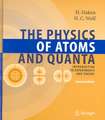Foundations of Nanomechanics: From Solid-State Theory to Device Applications: Advanced Texts in Physics
Autor Andrew N. Clelanden Limba Engleză Hardback – 18 oct 2002
| Toate formatele și edițiile | Preț | Express |
|---|---|---|
| Paperback (1) | 591.47 lei 6-8 săpt. | |
| Springer Berlin, Heidelberg – 18 iun 2011 | 591.47 lei 6-8 săpt. | |
| Hardback (1) | 653.14 lei 6-8 săpt. | |
| Springer Berlin, Heidelberg – 18 oct 2002 | 653.14 lei 6-8 săpt. |
Din seria Advanced Texts in Physics
- 18%
 Preț: 792.96 lei
Preț: 792.96 lei -
 Preț: 480.02 lei
Preț: 480.02 lei - 15%
 Preț: 590.30 lei
Preț: 590.30 lei -
 Preț: 202.50 lei
Preț: 202.50 lei - 15%
 Preț: 468.57 lei
Preț: 468.57 lei - 15%
 Preț: 710.75 lei
Preț: 710.75 lei - 15%
 Preț: 475.62 lei
Preț: 475.62 lei - 15%
 Preț: 571.96 lei
Preț: 571.96 lei -
 Preț: 393.35 lei
Preț: 393.35 lei -
 Preț: 395.47 lei
Preț: 395.47 lei -
 Preț: 403.75 lei
Preț: 403.75 lei -
 Preț: 413.15 lei
Preț: 413.15 lei - 15%
 Preț: 658.70 lei
Preț: 658.70 lei - 18%
 Preț: 778.74 lei
Preț: 778.74 lei - 18%
 Preț: 720.53 lei
Preț: 720.53 lei - 18%
 Preț: 975.10 lei
Preț: 975.10 lei -
 Preț: 412.78 lei
Preț: 412.78 lei - 15%
 Preț: 713.69 lei
Preț: 713.69 lei -
 Preț: 402.76 lei
Preț: 402.76 lei - 15%
 Preț: 588.50 lei
Preț: 588.50 lei - 15%
 Preț: 542.04 lei
Preț: 542.04 lei - 15%
 Preț: 651.84 lei
Preț: 651.84 lei - 18%
 Preț: 739.81 lei
Preț: 739.81 lei - 15%
 Preț: 646.11 lei
Preț: 646.11 lei - 23%
 Preț: 676.67 lei
Preț: 676.67 lei - 18%
 Preț: 730.79 lei
Preț: 730.79 lei - 15%
 Preț: 644.30 lei
Preț: 644.30 lei - 15%
 Preț: 543.34 lei
Preț: 543.34 lei - 15%
 Preț: 652.17 lei
Preț: 652.17 lei -
 Preț: 388.52 lei
Preț: 388.52 lei - 15%
 Preț: 605.20 lei
Preț: 605.20 lei - 18%
 Preț: 798.50 lei
Preț: 798.50 lei - 18%
 Preț: 1852.57 lei
Preț: 1852.57 lei - 18%
 Preț: 947.85 lei
Preț: 947.85 lei - 18%
 Preț: 969.44 lei
Preț: 969.44 lei
Preț: 653.14 lei
Preț vechi: 768.40 lei
-15% Nou
Puncte Express: 980
Preț estimativ în valută:
124.99€ • 135.72$ • 104.99£
124.99€ • 135.72$ • 104.99£
Carte tipărită la comandă
Livrare economică 22 aprilie-06 mai
Preluare comenzi: 021 569.72.76
Specificații
ISBN-13: 9783540436614
ISBN-10: 3540436618
Pagini: 452
Ilustrații: XII, 436 p.
Dimensiuni: 155 x 235 x 29 mm
Greutate: 0.77 kg
Ediția:2003
Editura: Springer Berlin, Heidelberg
Colecția Springer
Seria Advanced Texts in Physics
Locul publicării:Berlin, Heidelberg, Germany
ISBN-10: 3540436618
Pagini: 452
Ilustrații: XII, 436 p.
Dimensiuni: 155 x 235 x 29 mm
Greutate: 0.77 kg
Ediția:2003
Editura: Springer Berlin, Heidelberg
Colecția Springer
Seria Advanced Texts in Physics
Locul publicării:Berlin, Heidelberg, Germany
Public țintă
GraduateCuprins
1. Introduction: Linear Atomic Chains.- 2. Two- and Three-Dimensional Lattices.- 3. Properties of the Phonon Gas.- 4. Stress and Strain.- 5. Elasticity Relations.- 6. Static Deformations of Solids.- 7. Dynamical Behavior of Solids.- 8. Dissipation and Noise in Mechanical Systems.- 9. Experimental Nanostructures.- 10. Nanostructure Fabrication I.- 11. Nanostructure Fabrication II.- A. Mathematical Tools.- A.1 Scalars, Vectors, Tensors.- A.1.1 Vectors.- A.1.2 Tensors.- A.2 Eigenvectors and Eigenvalues.- A.3 The Dirac Delta Function.- B. Compatibility Relations for Stress and Strain.- C. Notation.
Recenzii
From the reviews:
PHYSICS TODAY (MAY 2004)
"The potential for the field of nanotechnology to transform civilization—with major applications in areas that span materials, biology, manufacturing, and information technology—is breathtaking … Progress in nanoscale technology requires a fundamental understanding of the intermediate realms between those scales and a concomitant educational effort to transform into applications the knowledge that scientists have gained in those realms. Foundations of Nanomechanics: From Solid-State Theory to Device Applications, a text on the solid mechanics of very small objects, addresses this educational need head-on. Andrew Cleland is intimately familiar with the task he undertakes in this book … The book, aimed at advanced undergraduates and beginning graduate students, joins in one treatise an engineering treatment of solids as continuum objects with a condensed matter physics focus on the quantum mechanical nature of solids. Beginning with a bottom-up atomistic description of matter, Cleland seamlessly works his way up, in the first seven chapters, to a continuum description of matter. Topics range from the dynamical motion of a two-atom system and the quantum and thermodynamic behavior of linear chains to atomic lattices, elasticity and deformation of solids, and the dynamical behavior of solids. The final chapters are devoted to dissipation and noise—topics that loom large at the nanoscale—and experimental fabrication techniques for today's nanostructures … The most apparent use for Cleland's book is in a semester- or year-long, special topic course on nanomechanics. The author also suggests it as a useful reference for the practicing scientist or engineer … Used a little or used a lot, Foundations of Nanomechanics will be useful all around!"
"The book, aimed at advanced undergraduates and beginning graduate students, joins in one treatise an engineering treatment ofsolids as continuum objects with a condensed matter physics focus on the quantum mechanical nature of solids. … No book … fills the unique role provided by Cleland’s monograph. … Used a little or used a lot, Foundations of Nanomechanics will be useful all around!" (Jacqueline Krim, Physics Today, May, 2004)
PHYSICS TODAY (MAY 2004)
"The potential for the field of nanotechnology to transform civilization—with major applications in areas that span materials, biology, manufacturing, and information technology—is breathtaking … Progress in nanoscale technology requires a fundamental understanding of the intermediate realms between those scales and a concomitant educational effort to transform into applications the knowledge that scientists have gained in those realms. Foundations of Nanomechanics: From Solid-State Theory to Device Applications, a text on the solid mechanics of very small objects, addresses this educational need head-on. Andrew Cleland is intimately familiar with the task he undertakes in this book … The book, aimed at advanced undergraduates and beginning graduate students, joins in one treatise an engineering treatment of solids as continuum objects with a condensed matter physics focus on the quantum mechanical nature of solids. Beginning with a bottom-up atomistic description of matter, Cleland seamlessly works his way up, in the first seven chapters, to a continuum description of matter. Topics range from the dynamical motion of a two-atom system and the quantum and thermodynamic behavior of linear chains to atomic lattices, elasticity and deformation of solids, and the dynamical behavior of solids. The final chapters are devoted to dissipation and noise—topics that loom large at the nanoscale—and experimental fabrication techniques for today's nanostructures … The most apparent use for Cleland's book is in a semester- or year-long, special topic course on nanomechanics. The author also suggests it as a useful reference for the practicing scientist or engineer … Used a little or used a lot, Foundations of Nanomechanics will be useful all around!"
"The book, aimed at advanced undergraduates and beginning graduate students, joins in one treatise an engineering treatment ofsolids as continuum objects with a condensed matter physics focus on the quantum mechanical nature of solids. … No book … fills the unique role provided by Cleland’s monograph. … Used a little or used a lot, Foundations of Nanomechanics will be useful all around!" (Jacqueline Krim, Physics Today, May, 2004)
Textul de pe ultima copertă
This text provides an introduction, at the level of an advanced student in engineering or physics, to the field of nanomechanics and nanomechanical devices. It provides a unified discussion of solid mechanics, with notation consistent with modern convention. A discussion of electrical transducer applications is included, covering such topics as piezoresistance and piezoelecticity. The text includes a discussion of fundamental and spurious sources of noise, and how these sources affect both the amplitude and phase of a mechanical resonator. A brief discussion of nonlinearity in mechanical systems is given. Demonstrated applications of these devices, as well as an introduction to fabrication techniques, are also discussed; a primer on optical as well as electron beam lithography is given in two concise chapters. The text concludes with an overview of potential future technologies, including a discussion of carbon nanotubes and other molecular assemblies.
Caracteristici
First textbook in the engineering field of nanomechanics Describes the solid-state-sciences background of nanomechanics, important for the design of micro- and nanomechanical electrical systems Reviews the current state-of-the-art in nanomechanics and nanoelectromechanics Numerous exercises help to deepen the students' understanding of the material Includes supplementary material: sn.pub/extras









